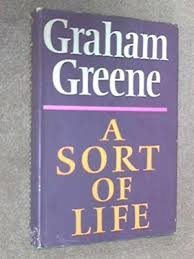“I can remember very clearly the afternoon I found the revolver in the brown deal corner-cupboard in a bedroom which I shared with my elder brother.”

That sentence, as tantalizing, evocative, and concise as anything Graham Greene wrote in his fiction appears, in fact, about halfway through his first volume of memoirs, A Sort of Life. It introduces a short confession of a brief time in the autumn of 1923 when the young Greene dabbled in Russian roulette. Six times over the course of a few months, the eighteen or nineteen year old undergraduate sought the “kick of excitement” of the “adrenaline drug” that taking the one-in-six chance of a revolver fired at the head provided.
Greene carried out this what we might call today “risky behavior” alone and in secret. His account, written with the hindsight of some forty-five years, and served up with customary sangfroid, is not calculated for shock or to engender sympathy. It is shared, merely, as a piece of the puzzle that Greene assembles into an autobiography, which, he admits, can only be “a sort of life.” “And the motive for recording these scraps of the past?” he asks. “It is much the same motive that has made me a novelist: a desire to reduce a chaos of experience to some sort of order, and a hungry curiosity. We cannot love others, so the theologians teach, unless in some degree we can love ourselves, and curiosity too begins at home.”
Home, for the child born Henry Graham Greene in 1904, was Hertfordshire, north of London, where his father was headmaster of Berkhamsted School. Despite his father’s position, or perhaps because of it, Graham was never particularly happy amid the school culture, preferring solitary reading to sports. As he looks back, he offers impressionistic memories rather than any strict chronology of events. Colorful episodes involving the first stirrings of sexual awakening, or the abiding unhappiness that prompted his being sent away from home to undergo treatment with a psychiatrist, or dabbling in espionage at a surprisingly young age, are presented in an almost sketchy manner, as if we already know the facts and Greene is finally explaining the subtext.
So the purpose in reading A Sort of Life is not to garner the facts of Greene’s life—there have been plenty of biographies written to provide those. No, what comes from reading this book, as perhaps came from the writing of it for Greene himself, is an attempt to capture the writer’s elusive nature under glass. It seems that, even at age sixty-six, as he set down these reminiscences from the perch of his considerable success, Greene was still unsure about his place in the world as an artist and as a man. There is an intentional pun in the title, of course, and Greene is certainly sorting through a muddle of memories to try to understand whence came his success as a writer—which he, tellingly, says “is always temporary,” adding, “success is only a delayed failure.”
Greene’s late adolescent flirtation with the loaded chamber of a revolver, then, becomes his abiding metaphor. “A kind of Russian roulette remained too a factor in my later life,” he realizes, “so that without previous experience of Africa I went on an absurd and reckless trek through Liberia; it was the fear of boredom which took me to Tabasco during the religious persecution, to a léproserie in the Congo, to the Kikuyu reserve during the Mau-Mau insurrection, to the emergency in Malaya and to see the French war in Vietnam. There, in those three regions of clandestine war, the fear of ambush served me just as effectively as the revolver form the corner-cupboard in the life-long war against boredom.”
From that blessed boredom came some rather great fiction.

